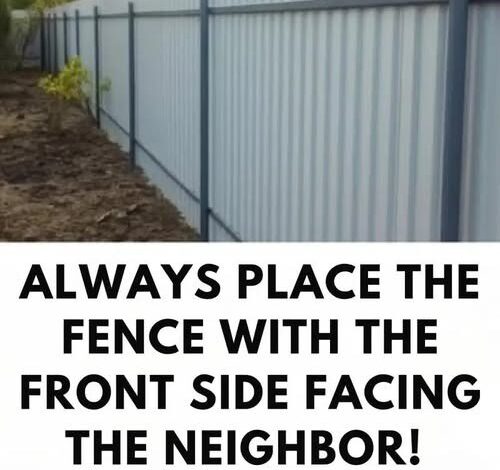
Fence Front Facing, Neighbor-Friendly Tips!
When most homeowners decide to build a fence, their minds go straight to practical concerns—privacy, safety for children or pets, and extra security for their property. While those priorities make sense, there’s another principle that carries equal weight but often gets overlooked: the orientation of the fence.
The rule is simple yet powerful—always face the finished, polished side of the fence toward your neighbor’s property. That choice may seem cosmetic, but in reality it has far-reaching effects on relationships, compliance with regulations, and even the value of your home.
A Matter of Respect and Courtesy
Imagine standing in your yard and looking out at a clean, smooth, well-painted fence. It adds beauty and makes the property line feel orderly. Now imagine the opposite: staring at exposed posts, crossbars, and nails sticking out from an unfinished side. The first feels like respect; the second, like disregard.
By placing the finished side outward, you’re sending a message of thoughtfulness. You’re essentially telling your neighbor, “I care about how this affects you, not just me.” This small act of consideration can foster goodwill and prevent resentment. Fences often carry symbolic weight—they can feel like barriers if handled poorly or like shared boundaries when approached with courtesy.
Disputes between neighbors frequently begin over small things: tree branches, loud music, parking. Adding the frustration of looking at the “ugly” side of someone’s fence is unnecessary fuel on a fire. A considerate orientation avoids that problem altogether.
The Legal and Regulatory Side
Beyond the social courtesy, there are also legal and regulatory reasons to face the polished side outward. Many municipalities, zoning boards, and homeowner associations have written guidelines that require the smooth, finished side to face the outside world. These rules exist to keep neighborhoods cohesive and visually pleasant.
Failing to follow them could result in complaints, citations, fines, or even an order to rebuild sections of your fence. That means more time, money, and stress than if you had planned it correctly from the start. Some communities even perform inspections to ensure new fences meet aesthetic codes.
Before you start digging post holes, check local ordinances and HOA bylaws. A quick review can save you from expensive modifications and strained neighborly relationships later.
The Impact on Property Value
Curb appeal is one of the biggest factors in real estate. A well-kept, attractive exterior instantly boosts perceived value. A fence with its finished side facing outward contributes to that visual harmony. It frames your property in a polished way and makes the neighborhood itself look more cared-for.
On the flip side, a row of houses lined with exposed structural boards and metal brackets creates a neglected, industrial feel. Potential buyers notice those details and may subconsciously lower their impression of the home and even the entire block. A fence that looks like an afterthought can quietly chip away at resale value.
Global and Cultural Traditions
This idea isn’t just a Western standard. Across many cultures, showing the more polished side of a fence or wall toward others is a symbolic gesture of respect. It reflects a universal value: acknowledging that we share space with others, and our choices affect them, too.
In rural communities, where neighbors often depend on each other, this tradition of facing the better side outward has existed for centuries. It transforms a simple boundary into a shared point of pride, rather than a source of conflict.
Practical Design Solutions
Of course, there are options that eliminate the “good side/bad side” dilemma altogether. A double-sided fence—sometimes called a shadowbox or board-on-board design—looks finished on both sides. While more expensive, it’s an excellent solution for long-term harmony, especially in neighborhoods where appearances matter greatly.
If you go with a standard design, remember that maintenance is just as important as orientation. Regular painting, staining, or sealing protects the wood and keeps it attractive. Loose boards or peeling paint on your neighbor’s side will still reflect poorly on you, even if you installed the fence correctly.
The Bigger Picture: Building Community
Ultimately, how you orient your fence says something about how you view community. A fence isn’t only about protecting your privacy—it’s also about coexisting respectfully with those who share the street, the block, the town.
By making the choice to face the finished side outward, you do more than comply with rules or enhance curb appeal. You create a symbol of cooperation and empathy. You show that even in something as seemingly minor as fence orientation, you’re willing to consider the perspective of the people living right beside you.
Final Thoughts
When planning your fence, think beyond the basics of height, material, and cost. Ask yourself what message you want it to send. A fence with its polished face turned outward is not just about looks—it’s a gesture of civility and mutual respect.
It can help you avoid legal headaches, preserve property values, and most importantly, strengthen neighborly bonds. A fence is, by nature, a barrier. But if built with courtesy, it can also become a bridge of understanding, showing that thoughtful property ownership extends beyond your own yard and into the lives of those around you.
So when the time comes to set those posts, remember the simplest rule of all: the good side always faces out. It’s more than aesthetics—it’s a sign of respect, compliance, and community spirit.




